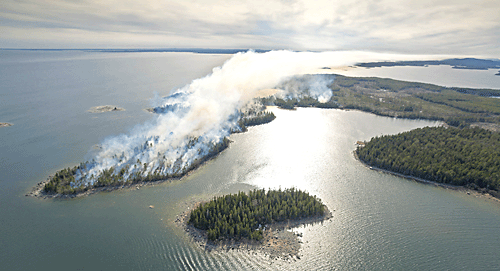Holmen Skog Uses Forest Fires for Better Nature Conservation
 Print this article | Send to Colleague Print this article | Send to Colleague
According to Sweden-based Holmen Skog, Iggesund Paperboard's sister company and forest raw material supplier, modern forest management tries to develop felling methods that resemble the effects of a natural forest fire. Forest fires have served an important ecological function for millennia, the company notes. As a result, the planned and controlled burning of forested areas is becoming increasingly common in the Swedish forest industry.
Earlier this summer, Holmen Skog burned an area on the island of Innerstön, one of the group of Baltic islands that lie offshore from the city of Hudiksvall north of Iggesund. By burning standing timber in controlled circumstances, Holmen says it is implementing an important nature conservation measure that benefits a number of rare species. During the next 16 years, all forests on the island, totaling 380 hectares, will be burned in stages.
"There's not enough burned forest at present," explains Magnus Aretorn, who is in charge of caring for the Holmen Skog forests in the Iggesund region and responsible for nature conservation measures. "By having frequent and recurring fires, we will create a mosaic of burned timber at various stages of decomposition. This will create an environment that is unique in Sweden and will benefit rare species that depend on heat from the fires or on various stages of decomposed, dead, or burned timber."
Examples of Swedish species that benefit from these special conditions are the cranesbill plants Geranium bohemicum and Geranium lanuginosum, the lichen Hypocenomyce anthracophila, the black fire beetle Melanophila acuminata and various species of the powderpost beetle Stephanopachys. Forest fires have many ecological functions and are an important aspect of the cycle of nature, the company points out. For millennia the forests have burned at irregular intervals, often as a result of lightning. Nowadays these fires are put out far more efficiently than before. The result is that few burned forest environments are created naturally. Holmen therefore implements controlled burns on some of its forest land.
Innerstön is surrounded by water and lies in a sheltered setting, making it a safer location for a controlled burn than the mainland. The island has been divided into eight different zones. Each year one of these zones will be burned. By 2028 the entire island, totaling 380 hectares of standing timber, will have been burned. By 2030 the controlled burn will start again in the first zone.
"This might seem to be a long-term perspective but in our industry it's not," Aretorn says. "The raw material for the quality paperboard Invercote comes from our forests in this region. Here it takes between 80 to 100 years for a pine tree to grow. So to put it bluntly, we who are planting the trees now won't still be around when the time comes to harvest them."
The photo below shows a controlled burn on the island of Innerstön offshore from Iggesund Paperboard's mill.

|
|

